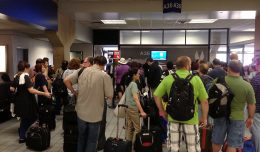The importance of evacuating an airplane after an accident cannot be overstressed. Except when depleted of fuel, aircraft have a strong propensity to burn after impact. Once the aircraft starts burning, statistically you’ve got 90 seconds to get out of there alive. After that point, your chance of making it out alive drops precipitously, and after two minutes, statistically, you’re dead.
 Nearly 25 years ago, TWA 843 slammed back on the runway at JFK after aborting the takeoff. Even though a majority of the exits were unable to be opened, the cabin crew evacuated everyone within two minutes. The accident was a proof of concept for cabin safety; the industry’s new and aggressive procedures for evacuating a cabin worked. In the years since, aircraft evacuations have been highly effective and a critical component of cabin safety for saving lives.
Nearly 25 years ago, TWA 843 slammed back on the runway at JFK after aborting the takeoff. Even though a majority of the exits were unable to be opened, the cabin crew evacuated everyone within two minutes. The accident was a proof of concept for cabin safety; the industry’s new and aggressive procedures for evacuating a cabin worked. In the years since, aircraft evacuations have been highly effective and a critical component of cabin safety for saving lives.
In 2015, a British Airways Boeing 777 caught fire in Las Vegas after an uncontained engine failure. The public was horrified by the pictures and videos of the billowing black smoke from the burning airplane. My horror was seeing passengers safely off the airplane, with their carry-on bags. This behavior was witnessed again with the evacuation of Emirates Flight 521 in 2016: passengers pausing to remove their personal items including their carry-on bags. These passengers are risking more than their own lives during this critical moment, but the lives of everyone who evacuates after them.
During an evacuation, flight attendants are trained to shout the evacuation orders along with the instruction to leave everything behind. Passengers that do not abide by this risk not only being publicly shamed on social media, but also risk prosecution by the civil aviation regulator and local authorities for doing so.
If there were to be an accident, and there were fatalities due to an ensuing fire, any passengers that hindered the evacuation to obtain their personal items could be held culpable for the lives of the passengers that had succumbed to the smoke and fire. By taking one’s luggage, a passenger would not be following the order of the cabin crew to leave everything behind. The passenger could then be brought up on the charge of interference with the crewmember, resulting in a judgement of several hundred or several thousand dollars by the government’s aviation regulatory body. In the United States, this would be the FAA and the case would be presided in front of an NTSB law judge.
The passenger’s culpability for the deaths of other passengers that were not able to evacuate could also land them in the public and civil court systems, charged with negligent homicide or involuntary manslaughter by the local prosecutor and families of the deceased. Pausing for a moment to take one’s bag during an evacuation could ultimately result in jail time as well as financial and emotional ruin.
Aircraft accidents are exceeding rare, and those requiring evacuations have been generally highly successful in the last quarter century. But both in this country and elsewhere in the world, there has been a disturbing trend of passenger disregard and complacency during evacuations. Statistically you’ve got 90 seconds to get out of a burning aircraft alive. The design and testing of the modern airliner, along with the training of the cabin crew all but assures you’ll be clear of the aircraft within that statistical 90 seconds. Passengers impeding the evacuation to collect their things greatly increase the risk that they and their fellow travelers will be statistics.
And they can be held responsible.







